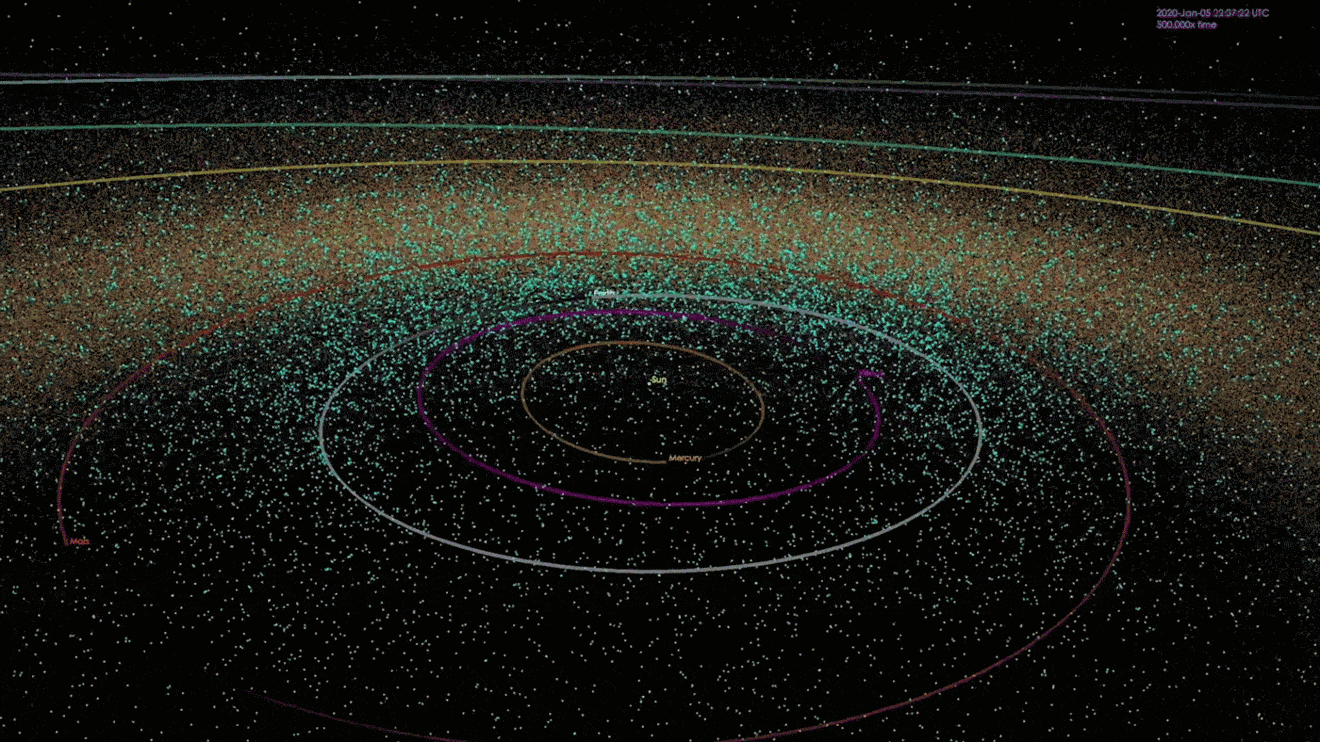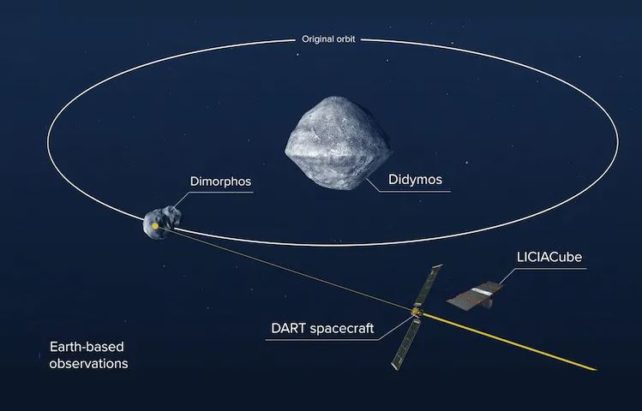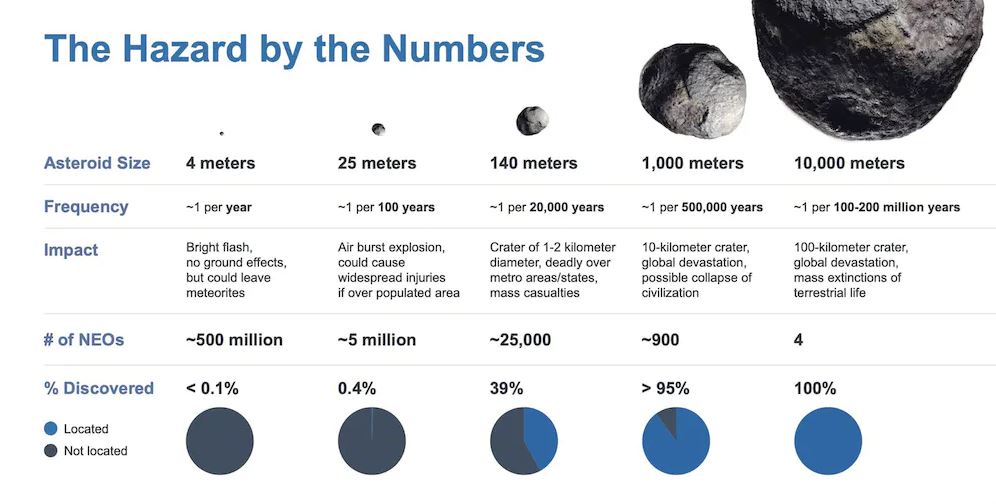
WATCH NASA SMASH INTO AN ASTEROID: Sixty-five million years ago, an asteroid struck Earth. Today, NASA strikes back. On Monday, Sept. 26th, the DART spacecraft will intentionally collide with asteroid Dimorphos in a test to see if human tech can change an asteroid's motion. Live coverage of DART's approach and impact (7:14 pm EDT) begins at 6:00 pm EDT on NASA TV. |
thanks cutworm!
I had no idea they were finally doing this.
A zillion times more important than the fake climate crisis that's causing the planet to green up and most life to benefit.
1 huge asteroid hit...........and it would be lights out for most life as we know it.
Only thing is that developing technology to do this doesn't have any massive self serving benefits to enrich the bloodsucking ticks of society.
Asteroids, sometimes called minor planets, are rocky, airless remnants left over from the early formation of our solar system about 4.6 billion years ago.
The current known asteroid count is:
1,113,527
.
Most of this ancient space rubble can be found orbiting the Sun between Mars and Jupiter within the main asteroid belt. Asteroids range in size from Vesta – the largest at about 329 miles (530 kilometers) in diameter – to bodies that are less than 33 feet (10 meters) across. The total mass of all the asteroids combined is less than that of Earth's Moon.
https://en.wikipedia.org/wiki/List_of_exceptional_asteroids
The following is a collection of lists of asteroids of the Solar System that are exceptional in some way, such as their size or orbit. For the purposes of this article, "asteroid" refers to minor planets out to the orbit of Neptune, and includes the dwarf planet 1 Ceres, the Jupiter trojans and the centaurs, but not trans-Neptunian objects (objects in the Kuiper belt, scattered disc or inner Oort cloud). For a complete list of minor planets in numerical order, see List of minor planets.
The number of bodies grows rapidly as the size decreases. Based on IRAS data there are about 140 main-belt asteroids with a diameter greater than 120 km.[6] For a more complete list, see List of Solar System objects by size.
The inner asteroid belt (defined as the region interior to the 3:1 Kirkwood gap at 2.50 AU) has few large asteroids. Of those in the above list, only 4 Vesta, 19 Fortuna, 6 Hebe, 7 Iris and 9 Metis orbit there. (Sort table by mean distance.)
Below are the sixteen most-massive measured asteroids.[7] Ceres, at a third the estimated mass of the asteroid belt, is half again as massive as the next fifteen put together. The masses of asteroids are estimated from perturbations they induce on the orbits of other asteroids, except for asteroids that have been visited by spacecraft or have an observable moon, where a direct mass calculation is possible. Different sets of astrometric observations lead to different mass determinations; the biggest problem is accounting for the aggregate perturbations caused by all of the smaller asteroids.[8]

Only Vesta is regularly bright enough to be seen with the naked eye. Under ideal viewing conditions with very dark skies, a keen eye might be able to also see Ceres, as well as Pallas and Iris at their rare perihelic oppositions.[12] The following asteroids can all reach an apparent magnitude brighter than or equal to the +8.3 attained by Saturn's moon Titan at its brightest, which was discovered 145 years before the first asteroid was found owing to its closeness to the easily observed Saturn.
None of the asteroids in the outer part of the asteroid belt can ever attain this brightness. Even Hygiea and Interamnia rarely reach magnitudes of above 10.0. This is due to the different distributions of spectral types within different sections of the asteroid belt: the highest-albedo asteroids are all concentrated closer to the orbit of Mars, and much lower albedo C and D types are common in the outer belt.
https://www.space.com/51-asteroids-formation-discovery-and-exploration.html
Near-Earth asteroids (NEAs) circle the sun at about the same distance as Earth does. These objects are split into sub-categories based on how the asteroid's orbit compares to Earth's, according to NASA (opens in new tab).
For example, Amor asteroids have orbits that approach Earth's path but remain exclusively between Earth and Mars. Apollo asteroids have Earth-crossing orbits but spend most of their time outside the planet's path. Aten asteroids also cross Earth's orbit but spend most of their time inside Earth's orbit. Atira asteroids are near-Earth asteroids whose orbits are contained within Earth's orbit.
Astronomers also classify certain near-Earth asteroids as "Potentially Hazardous Asteroids" or PHAs. These rocks come within about 4.65 million miles (7.48 million kilometers) of Earth's orbit and are larger than about 500 feet (140 meters) across, according to NASA's Center for Near-Earth Object Studies (opens in new tab) (CNEOS). However, the classification does not imply that the asteroid poses a certain threat to Earth.
As of October 2021, scientists have discovered more than 27,000 near-Earth asteroids, according to CNEOS. Of these, just under 10,000 have diameters larger than 500 feet.

metmike: This is a wonderful article!
published
You don't have anything to worry about right now, scientists emphasize.
Let's start with the most important takeaway: NASA knows of zero asteroids large enough to do meaningful damage on Earth and currently on track to collide with our planet in the foreseeable future. But large asteroids hanging around Earth? We've spotted plenty of those, and scientists are discovering new near-Earth asteroids practically daily, with more than 27,000 identified to date.

The art of protecting Earth from an asteroid impact is called planetary defense, and there are two key stages to the process. NASA's Double Asteroid Redirection Test (DART), launching later this month, is a mission designed to test the second stage of planetary defense, diverting a threatening asteroid from crossing paths with Earth.
But before anyone can even try to divert an asteroid, scientists have to find the space rock and map out its orbit many years into the future to realize that it will or may hit Earth.
"People might think planetary defense is all about deflecting asteroids but it's not," Nancy Chabot, a planetary scientist at the Johns Hopkins University Applied Physics Laboratory in Maryland and the coordination lead for DART, told Space.com. "Keeping track of the actual asteroids, identifying them and finding them is really crucial toward being able to do anything about them in the future."
Scientists have identified some 750,000 asteroids to date, but suspect there are millions of space rocks ricocheting through the full solar system. Fortunately, plenty of those stay far, far from Earth — consider, for example, residents of the main asteroid belt or the Trojan asteroids that flank Jupiter in its orbit.
In Earth's neck of the woods, that number comes down somewhat: Scientists have identified more than 27,000 near-Earth asteroids, with new ones spotted daily.
Related: If an asteroid really threatened the Earth, what would a planetary defense mission look like?

Those discoveries are thanks to a team of instruments on Earth and in space that dedicate some or all of their time to spotting and cataloging asteroids. The vast majority of these discoveries have come since the late 1990s, although experts were warning of the threat posed by asteroids before then without much success.
"If you talk to the scientists who were studying this in the '80s, there's a phrase they often refer to called the giggle factor," Carrie Nugent, a planetary scientist at Olin College in Massachusetts, told Space.com. "They're basically saying that they couldn't talk about this scientific topic without people kind of laughing at them."
The work was quite difficult then, as well, with surveys relying on photographic film developed in a darkroom then used with a device that helped a human brain recognize asteroids moving against background stars. Now, modern cameras and computer programs can bear much of the brunt of identification work.
So the rise of asteroid detections has been in part a matter of technology. But increasing funding was also key, which made reducing the giggle factor vital.
One milestone was Comet Shoemaker-Levy 9's impact of Jupiter in 1994, which unexpectedly left a mark in Jupiter's clouds the size of Earth that lingered for months. "People started to think, 'Whoa, if that happened to Jupiter, what would happen if that hit Earth?'" Nugent said.
Congress got on board with prioritizing asteroid hunting, calling on NASA to identify at least 90% of first the largest asteroids, then medium ones. Today, there's a whole host of projects that detect near-Earth asteroids, whether it's their top priority or an opportunity they can make use of.
Leading the charge today are programs like the Catalina Sky Survey based in Arizona that specializes in catching smaller asteroids, the Pan-STARRS observatory in Hawaii that excels at spotting faint objects, the NEOWISE space telescope that can see the whole sky and the ATLAS telescopes in Hawaii that are tuned to the fastest-moving objects.
"It's kind of like the ecosystem, everyone has their role," Nugent said. "Everyone kind of works together with their own strengths to really cover the sky."
Others chip in when luck permits. "Wide-field survey telescopes are set up for other purposes like for astrophysics investigations for instance, and then they end up getting the asteroids that photobomb them," Fast said.
And asteroid hunters are looking forward to a few new instruments joining the team soon. Planetary defenders are particularly excited to see the Vera C. Rubin Observatory in Chile begin observing in 2023; a space-based mission called NEO Surveyor is also in development and scheduled to launch later this decade.
"There's been a lot of work done to predict how many objects both [missions] will find, and those numbers are incredibly large," Nugent said. "It should be a huge increase in the number of asteroids and comets found, and that's always really exciting."
But surveys on their own aren't enough for planetary defense experts — follow-up observations are crucial to give scientists the data they need to accurately calculate an object's orbit. "That's the key part there," Fast said. "You want to know the asteroid's there, but you really want to know where it's going to be in the future and whether Earth is going to be in the same place at the same time."

If all those observations find that an asteroid is over a certain brightness (which suggests a certain size, although the two factors don't correlate precisely) and will come within 4.65 million miles (7.48 million kilometers) of Earth, the object is automatically dubbed a "potentially hazardous asteroid." (The distance works out to one-twentieth of the average distance between Earth and the sun.)
But in most cases, despite the ominous terminology, "potentially hazardous asteroids" may as well be called "not currently hazardous asteroids." After all, these are the objects that scientists have already found, and followed, and mapped, and forecast into the future.
"It's not like I look at a potentially hazardous object and, like, break out into a cold sweat," Nugent said. "It just means that it's something we want to keep an eye on."
To those who dedicate their careers to watching the skies for an apocalypse, the asteroids not yet identified are far more terrifying; these asteroids are the ones that can pop up, suddenly uncomfortably close to Earth, too late for anyone to even try to change a rock's course.
Scientists believe they've found nearly all the largest asteroids — those larger than 3,300 feet (1 km) across — and know that these are the easiest to find anyway. And while tiny near-Earth asteroids are plentiful and difficult to find, they are also the most likely to fall apart harmlessly in Earth's atmosphere.
So it's the middle size category of asteroids — those more than 460 feet (140 meters) but less than 3,300 feet wide — that most worries planetary defense experts. "That's where it's more likely that an impact could happen," Fast said. "Even with those, we're talking maybe timescales of centuries or millennia."
As of the end of 2020, estimates suggested scientists have found just 40% of near-Earth objects of this size; this year has added 500 to the tally. While that number is impressive, NASA's planetary defense office estimates that at the current pace, it will take scientists 30 more years to have identified 90% of objects this size, a goal that Congress asked NASA to reach by 2020.
"There's more of them as you go down in size and we're still racking up the numbers every year," Fast said. "That's why the surveys are doing their job every night, so we aren't caught unaware."
Related stories:
— What would happen if an asteroid were going to hit Earth? A NASA scientist explains.
— Planetary defense experts use infamous asteroid Apophis to practice spotting dangerous space rocks
— Defending Earth against dangerous asteroids: Q&A with NASA's Lindley Johnson
The quest to map as many nearby asteroids as possible is why the tally of "potentially hazardous asteroids" and near-Earth objects in general is rising so dramatically. "It's so satisfying to see that number of asteroid discoveries creep up," Nugent said. "That feels good, it feels like you've accomplished something."
It's not just satisfying, she added — it's even comforting.
"I think it's a really nice example of science working," Nugent said. "You have a problem that seems scary, you work to understand it, it seems less scary because you know what you need to do. I think that's a really nice, calming thing about studying near-Earth asteroids."
A very good use of adjectives:
"Only thing is that developing technology to do this doesn't have any massive self serving benefits to enrich the bloodsucking ticks of society. "
The physics sounds simple, and it is. Hit one thing with another thing to change its motion. But the mission execution is very complicated.
When DART reaches the asteroids, it will be 11 million kilometers from Earth after a 10-month journey. The spacecraft has to use autonomous targeting, using images of the asteroids it acquires as it approaches.
DART needs to recognize the asteroids by itself, automatically lock onto Dimorphos, and adjust its trajectory to hit it. This is all while moving at a speed of nearly 24,000 kilometers (close to 15,000 miles) per hour!

